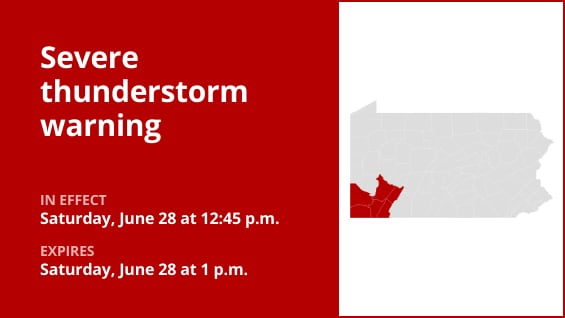The National Weather Service issued a revised severe thunderstorm warning for Greene, Washington, and Westmoreland counties on Saturday at 12:45 p.m., which is in force until 1 p.m.
Residents should be ready for 60 mph wind gusts.
“At 12:45 p.m., a severe thunderstorm was located over California, or 15 miles northwest of Uniontown, moving east at 25 mph,” according to the meteorological service. “Expect damage to roofs, siding, and trees.”
Donora, Monongahela, Charleroi, Bentleyville, Brownsville, Fredericktown-Millsboro, Perryopolis, Fairdale, Jefferson Boro, North Belle Vernon, Wickerham Manor-Fisher, Baidland, North Charleroi, Speers, Isabella, Belle Vernon, and Lynnwood-Pricedale are among the places affected by the warning.
“Avoid windows and seek shelter inside a sturdy building,” the weather agency advises. Winds from this storm have the potential to cause damage. This storm is causing lightning to strike the ground continuously from the clouds. One of nature’s greatest murderers is lightning. Keep in mind that lightning can strike you if you can hear thunder.
Preparing for impending lightning strikes: Expert safety recommendations
Approximately 25 million lightning strikes occur in the United States annually, with the majority of these electrical discharges taking place in the summer. Unfortunately, according to the weather service, lightning kills roughly 20 people every year. As thunderstorms approach, the likelihood of lightning-related incidents increases, peaking when the storm is directly overhead. But as the tempest sweeps away, it gradually fades away.
Consider the following advice to keep yourself safe during a thunderstorm:
Plan for lightning safety:
-
When venturing outdoors, it’s vital to establish a clear plan for seeking shelter in case of lightning.
-
Stay vigilant by monitoring the sky for ominous signs and listening for the telltale sound of thunder. If thunder is audible, it’s a clear indication of nearby lightning.
-
Seek shelter promptly in a safe location, preferably indoors.
Indoor safety precautions:
-
Once you’re indoors, avoid using corded phones, electrical devices, plumbing fixtures, and stay away from windows and doors.
-
Lightning can follow conductive pathways, and these precautions reduce the risk of electrical surges.
Hold off till the all-clear:
-
After the last lightning strike or thunderclap, wait at least 30 minutes before resuming outdoor activities.
-
It’s important to remember that lightning can strike even when a storm seems to have passed, so exercise caution.
When there is no indoor shelter:
Take these precautions to increase your safety if you are outside during a thunderstorm without access to inside shelter:
-
Avoid open fields, hilltops, or ridge crests, which expose you to greater lightning risk.
-
Steer clear of tall, isolated trees and other prominent objects. In forested areas, stay close to lower stands of trees.
-
If you’re with a group, ensure individuals are spread out to prevent lightning current from transferring between people.
-
Camping in an open setting during a thunderstorm is strongly discouraged. If you have no alternative, set up camp in a valley, ravine, or other low-lying areas. It’s crucial to note that a tent provides no protection against lightning.
-
Do not approach water bodies, wet objects, or metal items. While water and metal don’t attract lightning, they conduct electricity effectively and can pose significant risks.
In conclusion, being alert and ready are your best defenses against lightning threats. You may put your safety first and drastically lower the likelihood of lightning-related mishaps by adhering to these rules.
Navigating heavy rain: Essential safety measures for wet roads
Safety comes first when there is a lot of rain. To avoid dangers and navigate wet roads, arm yourself with these weather service guidelines:
Watch out for swift water flow:
Avoid parking or strolling close to culverts or drainage ditches during periods of intense precipitation, as the swift-moving water can be quite dangerous.
Keep your distances from other vehicles safe:
In heavy rain, the two-second rule of following distance is your friend. To guarantee safe spacing under unfavorable circumstances, increase it to four seconds.
Slow down and drive carefully:
Lowering your speed is essential on wet roads. To prevent skidding, gently release the gas pedal and refrain from applying sudden braking.
Pick your lane carefully:
To reduce the chance of hydroplaning, stay in the middle lanes. Water is more likely to accumulate in outside lanes.
Put visibility first.
As rain-spattered windows make it more difficult to see other vehicles, turn on your headlights and pay attention to those in blind spots and behind you.
Be cautious on slick roads:
During the first half hour after the rain starts, exercise additional caution. The road becomes slick when water combines with dirt and oil on the surface.
Stay a safe distance away from big cars:
Tire spray from big vehicles and buses can make it harder to see. Pass them quickly and safely, and refrain from tailgating.
Be mindful of your wipers:
Visibility may be hampered by overloaded wiper blades. If the rain makes it very difficult to see, stop and wait for the weather to clear up. Look for cover in covered areas or rest areas.
Position your car as far off the road as you can, preferably beyond guardrails, if stopping by the side of the road is your only choice. To let other cars know where you are, turn on your emergency flashers and keep your headlights on.
You may greatly lower dangers and protect your health when it rains a lot by adhering to these safety precautions. To ensure a safe and sound voyage, keep yourself updated on weather conditions and follow local authorities’ instructions.
United Robots offers a service called Advance Local Weather Alerts that gathers the most recent information from the National Weather Service using machine learning.






